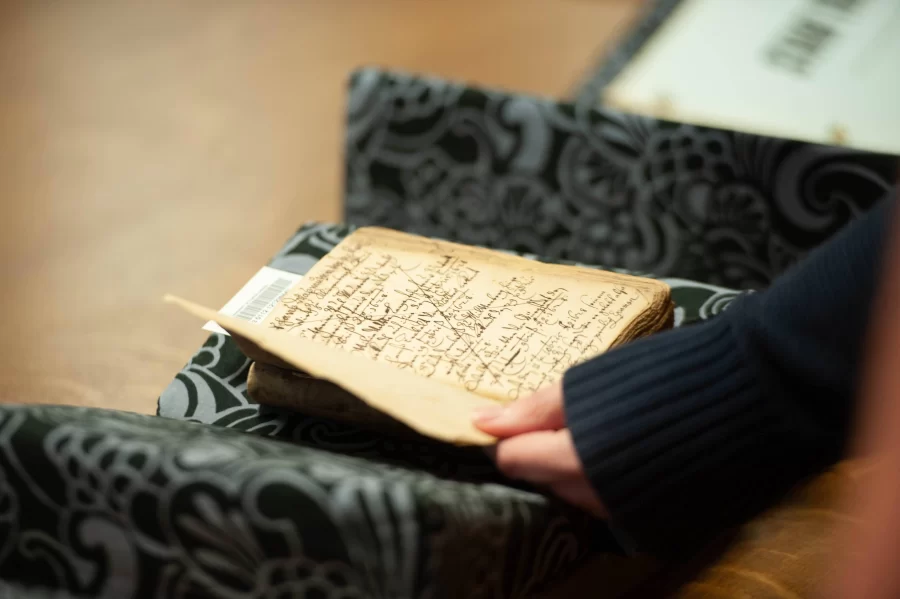Rare Book and Manuscript Library preserves centuries of history
Dr. Cait Coker, curator of the Rare Book and Manuscript Library, browses through one of the books from the collection on Oct. 14. The RBML houses nearly 500,000 volumes from literature to television scripts.
October 27, 2022
The Rare Book and Manuscript Library, or RBML, at the University of Illinois is one of the largest publicly accessible collections of rare books in the country. In the era of banned books, the RBML serves as a protector of the past.
The RBML was established in 1936. The contents of the library, which has nearly 500,000 volumes, range from English literature and Renaissance manuscripts to television scripts from shows such as Seinfeld and Friends.
Rare books, as defined by Dr. Cait Coker, the curator of the RBML, are books that have a certain uniqueness and limited quantity. Sometimes, rare books are categorized due to their age and are in need of special care to be preserved.
Coker said in other cases, the books have a “recognizable cultural cachet that needs to be protected.”
Within the past year, Americans have seen a growing push to censor and ban certain books. The American Library Association has documented 681 attempts to restrict or ban library resources throughout the first eight months of the year, with over 1,600 unique titles being challenged. The RBML works as an outlet to preserve history through rare books.
Get The Daily Illini in your inbox!
On the website of the RBML, their mission statement reads that the rare books and manuscripts are a “tangible part of the human record” and that they “preserve these cultural heritage materials to make them accessible to all who wish to connect with them, now and in the future.”
Coker said the books that she and other staff members curate fill “gaps in history.”
“(The books) are a documentary part of history, and if you’re not keeping materials, if you’re not documenting it, then you end up with a skewed sense of what the past is like,” Coker said. “I believe in open access to information and also protecting that information.”
The RBML prides itself on a shared sense of community, Coker said, allowing students to have the same amount of access as professors and other members of the community. The RBML makes sure to provide opportunities for people to have hands-on engagement with history.
When visitors enter the RBML, they often end up having an exchange of ideas and thoughts with staff, starting a conversation about events of the past.
The RBML also hosts events for elementary school children to explore the rare books themselves. Staff members educate young students on how the content of these books connects to the world today.
“That is an incredibly important moment for young people so they can see that knowledge is something to enjoy and love as opposed to having anxiety about,” Coker said. “Engaging with history is not scary.”
Lori Humphrey Newcomb, professor in LAS, has brought her students to visit the RBML.
“When my students turn the pages of a book and realize that its first readers turned those same pages four centuries ago, a past culture is at once more distinct and more tangible to them,” Newcomb said.
Although the RBML is one of the largest publicly accessible rare book libraries in the country, Coker said she believes University students do not take full advantage of its resources.
“I wish (students) knew how rare it is that they have access to something like this,” Coker said. “There are many other public institutions that do not have the same accessibility the students here do.”
Caroline Szylowicz, a librarian and curator for the RBML, attested to the accessibility of the library’s collection.
“We have the best collections and they are accessible to absolutely everyone,” Szylowicz said. “We sometimes have reputations as rare book libraries for being pretty restricted spaces, and we are not.”
Rylee Smith, senior in LAS, works at the RBML as a student assistant. Smith said that students should take better advantage of the library.
“I don’t think students realize how great our library system is here,” Smith said. “I learn new things about the library all the time, and I work here.”
The RBML allows students to explore the literary works from the likes of Gwendolyn Brooks and Carl Sandburg, or they can be greeted by over 4,000 miniature books at the front desk when they walk in.
Although students may be intimidated at first to enter the RBML, the rich history that can be accessed is at the tip of their fingers.
“You just have to show up, come to see something, bring your curiosity, bring yourself and we’ll find something to match your interests,” Szylowicz said.







